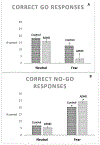Response Inhibition, Response Execution, and Emotion Regulation among Children with Attention-Deficit/Hyperactivity Disorder
- PMID: 30112596
- PMCID: PMC6377355
- DOI: 10.1007/s10802-018-0466-y
Response Inhibition, Response Execution, and Emotion Regulation among Children with Attention-Deficit/Hyperactivity Disorder
Abstract
Attention-deficit/hyperactivity disorder (ADHD) is associated with deficits in response inhibition, response execution, and emotion regulation. However, the nature of the associations among these deficits remains unclear. Thus, this study examines these associations using a multi-method design. One hundred sixty-six children (aged 5-13 years; 66.3% male; 75 with ADHD) completed two conditions (i.e., neutral and fear) of an emotional go/no-go task. Parasympathetic-based regulation was indexed via respiratory sinus arrhythmia (RSA), and sympathetic-based reactivity was indexed via cardiac pre-ejection period (PEP). Overall, children exhibited more difficulty with response execution (i.e., more omission errors, fewer correct go responses) and less difficulty with response inhibition (i.e., fewer commission errors, more correct no-go responses) during the fear condition than the neutral condition. Children with ADHD displayed more difficulty with response execution during the fear condition compared to typically developing youth. Additionally, children with ADHD displayed parasympathetic-based dysregulation (i.e., RSA increase from baseline) and reduced sympathetic-based reactivity (i.e., PEP lengthening) compared to typically developing youth across task conditions. In sum, children with ADHD demonstrate greater difficulty with response execution during emotionally salient contexts, as well as parasympathetic-based emotion dysregulation. Future work should examine these associations longitudinally with the aim of predicting impairment and treatment response in youth with ADHD.
Keywords: Attention-deficit/hyperactivity disorder; Autonomic nervous system; Emotion regulation; Response execution; Response inhibition.
Conflict of interest statement
Conflict of Interest: The authors declare that they have no conflict of interest.
Figures


References
-
- Adams RB, Ambady N, Macrae NC, & Kleck RE (2006). Emotional expressions forecast approach-avoidance behavior . Motivation and Emotion, 30, 177–186. doi: 10.1007/s11031-006-9020-2. - DOI
-
- American Psychiatric Association. (2013). Diagnostic Statistical Manual of Mental Disorders (5th ed.). Arlington, VA: American Psychiatric Publishing.
-
- Barkey RA (2004). Attention-deficit/hyperactivity disorder and self-regulation: Taking an evolutionary perspective on executive functioning In Baumeister RF & Vohs KD (Eds.), Handbook of self-regulation: Research, theory, and applications (pp.301–323). New York: Guillford Press.
Publication types
MeSH terms
Grants and funding
LinkOut - more resources
Full Text Sources
Other Literature Sources
Medical
Miscellaneous

